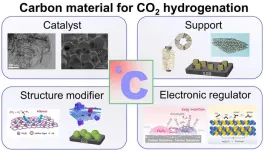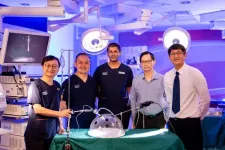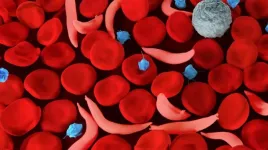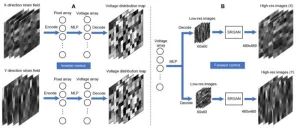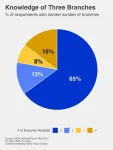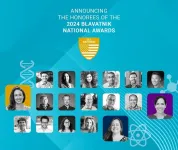(Press-News.org) One of the primary drivers of climate change, CO2 emissions, have reached over 35 million tons worldwide. With global annual temperatures still rising, reducing CO2 emissions has become a necessity. To turn this necessity into an opportunity, researchers have been working to find ways to capture the CO2, thereby reducing emissions and then converting that CO2 into valuable chemicals and fuels.
One of the difficulties in working with CO2 is that it is very thermodynamically stable. To overcome this, additional energy and a strong catalyst are needed to drive the reaction. A research group at China University of Petroleum (East China) has been investigating the use of carbon-based catalysts in the conversion process. They have designed several different very effective synthesis strategies using these catalysts in the catalytic conversion of CO2.
A review of their work was published in Carbon Future on September 10.
“In this review, we summarized the development strategy of catalysts by carbon species assisting method in our research group, which can be applied for CO2 thermochemical and electrochemical hydrogenation. This review aims to inspire new ideas for CO2 hydrogenation through the design of carbon-based catalysts,” said Mingbo Wu, a professor at the College of New Energy, State Key Laboratory of Heavy Oil Processing at the China University of Petroleum (East China) and lead author of the paper.
The researchers chose to focus on carbon species because their physical and chemical properties make them good candidates as catalysts, they can be relatively inexpensive and are very stable. Carbon-based catalysts can also play various roles in the preparation and process of CO2 catalytic conversion. They can be used to modify the structure of catalyst, as supports of catalyst, as electronic regulators of catalyst and as the bulk catalysts.
CO2 conversion occurs via CO2 hydrogenation, the addition of hydrogen atoms to the CO2 and removing its oxygen atoms. This is accomplished using either the energy from electrocatalysis, which uses electricity to drive the process, or thermocatalysis, which uses heat to drive the process. In order to avoid increasing the amount of pollutants and green-house gases, Wu’s team recommends using green renewable energy as the energy source wherever possible.
Wu’s team has designed and researched several different catalyst strategies. An example of one of these strategies is the electrocatalysis reduction of CO2 via a carbon-based catalytic material.
In essence, CO2 is converted to HCOO, formate, which is a nontoxic, easy to transport and very promising green fuel. The difficulty in designing these strategies lies in building a process that is both efficient and stable, hence the importance of the design of the process and the type of catalyst used. The researchers carried out the conversion using carburized iridium oxide nanorods, a metallic oxide. The process they designed uses the carbon species’ ability to modulate the electronic structure of metals, thus enhancing the activity of catalysts and selectivity of formate, said Wenhang Wang, a researcher from the School of Chemistry and Chemical Engineering at Liaocheng University and first author of the paper.
“We will always be committed to the development and application of carbon-based catalysts. With the development on the design concept of the catalyst and characterization technology, we strongly believe that a clear roadmap of the utilization of carbon materials for catalysts is drawn and the breakthrough in this field will be witnessed in the near future,” Wu said.
Other contributors include Wenhang Wang from the Shandong Provincial Key Laboratory of Chemical Energy Storage and Novel Cell Technology, School of Chemistry and Chemical Engineering, Liaocheng University, China and the College of New Energy, State Key Laboratory of Heavy Oil Processing, China University of Petroleum (East China), Qingdao, China; Yang Wang and Hui Ning from the College of New Energy, State Key Laboratory of Heavy Oil Processing, China University of Petroleum (East China), Qingdao, China; and Xiangjin Kong from the Shandong Provincial Key Laboratory of Chemical Energy Storage and Novel Cell Technology, School of Chemistry and Chemical Engineering, Liaocheng University, China.
This work was supported by the National Key Research and Development Program of China, the National Natural Science Foundation of China and the Taishan Scholar Project.
About Carbon Future
Carbon Future is an open access, peer-reviewed and international interdisciplinary journal, published by Tsinghua University Press and exclusively available via SciOpen. Carbon Future reports carbon-related materials and processes, including catalysis, energy conversion and storage, as well as low carbon emission process and engineering. Carbon Future will publish Research Articles, Reviews, Minireviews, Highlights, Perspectives, and News and Views from all aspects concerned with carbon. Carbon Future will publish articles that focus on, but not limited to, the following areas: carbon-related or -derived materials, carbon-related catalysis and fundamentals, low carbon-related energy conversion and storage, low carbon emission chemical processes.
About SciOpen
SciOpen is an open access resource of scientific and technical content published by Tsinghua University Press and its publishing partners. SciOpen provides end-to-end services across manuscript submission, peer review, content hosting, analytics, identity management, and expert advice to ensure each journal’s development. By digitalizing the publishing process, SciOpen widens the reach, deepens the impact, and accelerates the exchange of ideas.
END
Gastric cancer remains a formidable adversary, ranking as the fifth most common cancer and the third-leading cause of cancer-related deaths worldwide, with over 1,000,000 new cases and close to 770,000 deaths each year. In Singapore, gastric cancer ranks among the top 10 causes of cancer-related deaths and claims about 300 lives each year.
The peritoneum, the lining of the abdominal cavity, is frequently involved in advanced-stage cancers, including gastric, colon, pancreatic, and ovarian cancers. For gastric cancer, the peritoneum ...
National Institutes of Health (NIH) researchers and collaborators have found that being a carrier for sickle cell disease, known as having sickle cell trait, increases the risk of blood clots, a risk that is the same among diverse human populations that may not traditionally be associated with sickle cell disease. The study provides estimated clinical risks for people with sickle cell trait, which can inform clinical practice guidelines. Researchers examined the largest and most diverse set of people ...
(WASHINGTON – September 12, 2024) The risk of venous thromboembolism (VTE), or blood clots, in individuals with sickle cell trait (SCT) is higher than in individuals without the trait. However, the risk is lower than for those with heterozygous factor V Leiden (FVL), according to a study published today in Blood Advances that analyzed genetic data from 23andMe research participants.
More than 100 million people worldwide and approximately 7% of Black individuals in the United States have SCT. Unlike sickle cell disease, ...
A research paper by scientists at Purdue University presented a deep learning method that enables the customization of complex strain fields according to specific requirements.
The new research paper, published on Aug. 14 in the journal Cyborg and Bionic Systems, used a deep learning method based on image regression and achieved to predict and customize complex strain fields.
Traditional bioreactors, powered by pneumatic actuators or motors, struggle to generate complex strain fields due to limited control over individual actuators. However, fields like cardiovascular biomechanics and tissue engineering require more advanced customization. “In the field of biomechanics, customizing ...
Highlights:
Diastatic yeasts can spoil craft beer through hyperattenuation, which boosts the alcohol content and causes bottles to explode.
Killer toxins, which are produced by other yeast strains, hint at a remedy.
In a proof-of-concept study, researchers found that killer toxins inhibited up to 95% of diastatic yeasts.
More work is needed to fine tune the recipe, but killer yeasts may help brewers remedy potentially contaminated beers.
Washington, D.C. — Sept. 12, 2024 — When diastatic strains of Saccharomyces cerevisiae, ...
DALLAS, September 12, 2024 — The American Heart Association, celebrating 100 years of lifesaving service in 2024, is recognizing 21 students, educators and elementary, middle and high schools from across the country who are making a bold impact in the battle against cardiovascular disease – the nation’s leading cause of death. These exceptional individuals and institutions were honored for their unwavering commitment to the Association’s in-school programs, Kids Heart Challenge™ ...
A new study has revealed for the first time how different synthesis methods can profoundly impact the structural and functional properties of high entropy oxides, a class of materials with applications in everyday electronic devices. The study was published this week in the Journal of the American Chemical Society.
“The specific material that we’ve studied here is a high entropy oxide with a spinel crystal structure, which is a mixture of five different transition metal oxides. A lot of the excitement that we ...
Less than half of Americans can name most of the rights protected under the First Amendment and under two-thirds can name the three branches of government, according to the Annenberg Constitution Day Civics Survey, released annually since 2014.
The Annenberg Public Policy Center’s nationally representative survey, conducted in May 2024 with about 1,600 U.S. adults, finds levels of public knowledge largely unchanged from 2023. As was true last year, most Americans could name only a single right guaranteed by the First Amendment: freedom of speech, provided by nearly 3 in 4 respondents.
The survey also found strong public support for ...
NEW YORK, September 12, 2024 – For the second time, the Blavatnik Family Foundation and The New York Academy of Sciences named three women scientists as Laureates of the Blavatnik National Awards for Young Scientists. Each will receive $250,000, the largest unrestricted scientific prize offered to America’s most promising, faculty-level scientific researchers under 42. Three independent juries – one each for life sciences, chemical sciences, and physical sciences & engineering – composed of some of America’s most distinguished scientists selected the three winning Laureates. An additional 15 Finalists will each receive ...
After more than a decade of research growth and recruiting efforts to build strong, collaborative research programs, the Jerry H. Hodge School of Pharmacy in Amarillo has developed the Brain Drug Discovery Center, the newest Texas Tech University Health Sciences Center (TTUHSC) research center.
Created from two existing pharmacy school centers — the Center for Blood-Brain Barrier Research and the Cancer Biology Research Center — the Brain Drug Discovery Center will focus on ...
